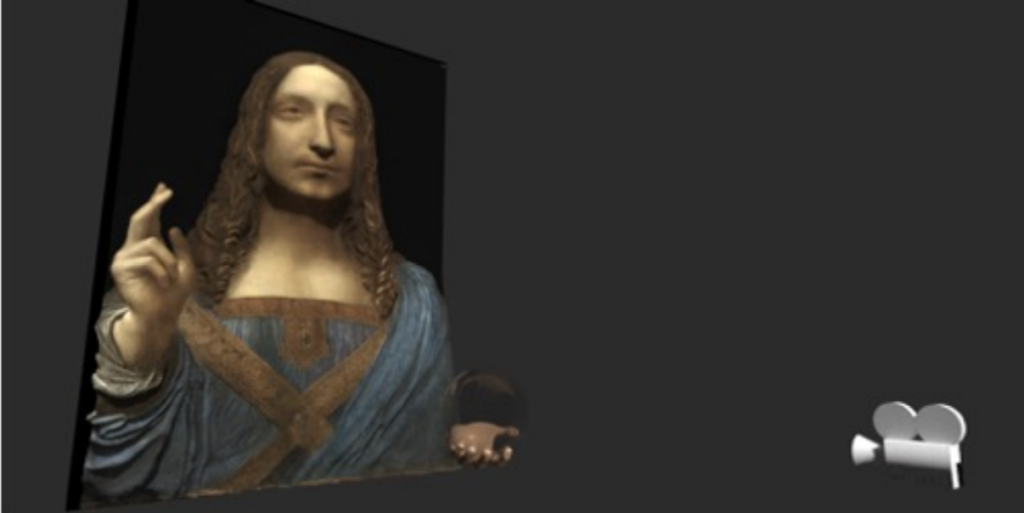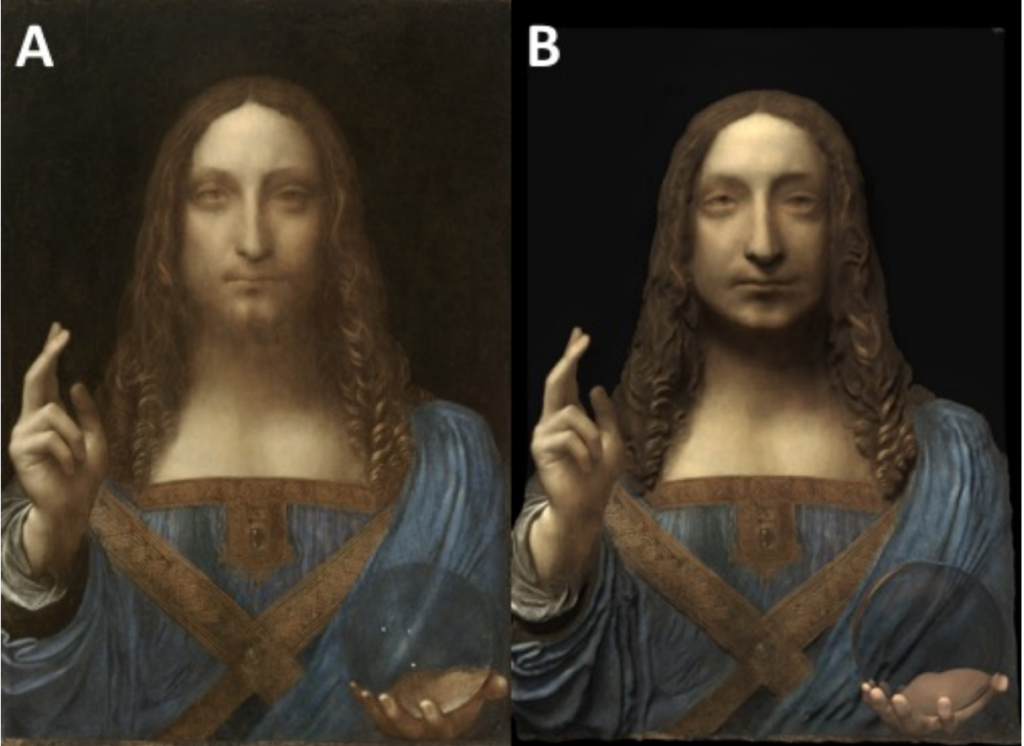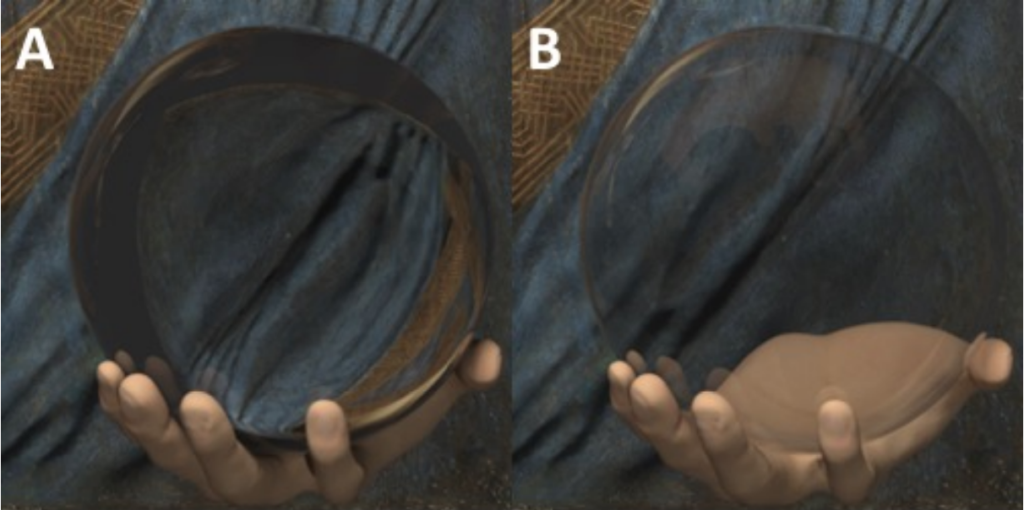Art World
Computer Scientists Say They’ve Solved the Mystery of the Orb in Leonardo da Vinci’s ‘Salvator Mundi’
The accuracy of the depiction of crystal in the painting has haunted fans of the world's most-expensive painting.

The accuracy of the depiction of crystal in the painting has haunted fans of the world's most-expensive painting.

Sarah Cascone

Computer scientists from the University of California, Irvine, have created a virtual copy of the world’s most expensive painting, the Salvator Mundi. And they are claiming that science can solve one of the greatest mysteries of one of the world’s most famous paintings.
In 2017, the painting sold at Christie’s for $450 million only to disappear from the public eye. Given the incredible price and the geopolitical mysteries surrounding its new ownership (it is reported to have been purchased by Saudi Arabian crown prince Mohammad bin Salman as a gift to the Louvre Abu Dhabi), all manner of conspiracy theories have surfaced around the painting. Much attention has focused on whether the extensively restored painting can be considered a Leonardo original at all, and one of the biggest questions concerns the crystal orb that Christ holds, which symbolizes the earth and is a key element of any composition featuring the “Salvator Mundi,” Latin for “Savior of the World.”
For instance, Michael Daley, director of ArtWatch UK, noted that one of his reasons for thinking the painting was not a Leonardo original was the fact that the orb didn’t refract light realistically, even though supposedly later copies of the painting did. Given the Renaissance artist’s keen interest in science, Daley said that it was unlikely that “Leonardo knew all about the optics, but just decided not to bother.” At the time, Christie’s countered that Leonardo’s paintings were “known for their mystery and ambiguity,” positing that “he chose not to portray it in this way because it would be too distracting to the subject of the painting.”
Now, however, a paper by Marco Zhanhang Liang, Michael T. Goodrich, and Shuang Zhao claims to have determined that the mysterious translucent globe in Christ’s hand may be scientifically accurate after all. Using “physically based rendering,” a sophisticated computer graphics tool that simulates light, as well as Maya, a 3-D modeling and animation software, the team synthesized how the figure of Christ would have been viewed through orbs of varying materials.
If the globe were a solid mass, it would act like a convex lens, inverting, reversing, and magnifying anything behind it, qualities not seen in Salvator Mundi. However, the rendering in the painting could still be optically accurate—if the glass orb depicted is hollow. This would explain the minimal distortion in the way Christ’s robe, seen through it, is painted.

Leonardo da Vinci, Salvator Mundi and a PBR rendering of the painting using a hollow orb. Courtesy of University of California, Irvine.
“A hollow orb… does not cause such distortion,” notes the paper, published on arXiv. After studying how light would refract through different types of orbs, they estimated that the glass of the orb in Salvator Mundi was a fraction of an inch thick, accounting for its ethereal optical quality.
Leonardo was fascinated by the way that glass interacted with light, and kept notebooks recording diagrams about optics. It stands to reason that the Renaissance great would have understood how light interacted with glass orbs and have been fully capable of depicting one with total optical accuracy.
The new finding changes the way people look at the painting, from all sides. While some have argued that the oddity of the glass ball is evidence that the work is actually by a lesser painter, Leonardo scholar Martin Kemp has said that it was the orb itself that convinced him of the work’s authenticity. He believes that it was made from rock crystal, noting the artist’s careful depiction of subtle “inclusions” in the material, and possibly a double refraction as would occur within a calcite sphere.

Rendering of a solid orb and a hollow orb in Leonardo da Vinci’s Salvator Mundi. Courtesy of University of California, Irvine.
Kemp previously told Artnet News that it was wrong to assume that Leonardo would necessarily have rendered the inversion one actually experiences when looking through a solid crystalline orb. “[T]his is to misunderstand Renaissance painting: it’s not a photograph,” he argued. “It’s a question of good manners. If you can imagine a baptism of Christ in which Christ’s legs are refracted by the River Jordan—they just wouldn’t do that. It’s pictorial bad manners. So here, he’s saying, ‘this is a rock crystal sphere,’ but he’s not following through on the implications of that to the bitter end.”
Yet if the scientists are correct and the depicted orb is hollow, rather than solid, then the Salvator Mundi actually would be true to life after all—a possibility already pointed out by Leonardo biographer Walter Isaacson, who made waves by noting the irregularity in the painting in the first place. “Leonardo failed to paint the distortion that would occur when looking through a solid clear orb at objects that are not touching the orb,” he wrote in his book. “Leonardo painted the orb as if it were a hollow glass bubble that does not refract or distort the light passing through it.”
Then again, the sphere’s appearance might still also be an artistic choice, Isaacson argued in a Facebook post refuting the possibility that the orb offered any reason to doubt the painting’s authorship: “I believe [Leonardo] made a decision to paint the crystal orb in a way that is miraculous and not distracting.”